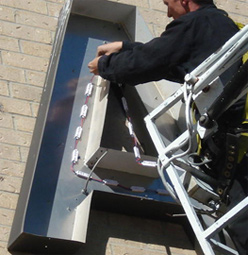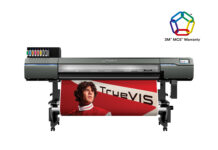When channel letter signs are past their prime, sign owners have several options. They can order an entirely new sign, or they can repair or replace only those sections where neon or fluorescent lighting has lost its luster.
Or they can rejuvenate said sign with an LED retrofit.
Business owners often turn to sign service providers for recommendations on what to do. Because of this, many sign shop owners now find the LED retrofit, properly pitched, can be an easy sell.
The promise of significant savings on energy, long life, and lower maintenance costs all resonate with the cost conscious.Consequently more and more channel letters are getting the LED treatment.
“LEDs have become the default answer for retrofitting neon in channel letters, since channel letters tend to be uniquely shaped,” says J. Bryan Vincent, co-founder and partner at Principal LED, an LED supplier that recently acquired all assets of its former competitor Ventex Technology. “LED modules are a natural replacement for neon tubing wherever you have closed-face channel letters.”
Mark Abernathy, director of sales for US LED, notes, “The only place where LEDs don’t fit the bill is where you have letters with exposed neon as part of the effect. Otherwise LEDs are really the easiest way to do a retrofit.”
Savings Incentives
Although one can be limited by the number of colors when using LEDs in channel letters, the manufacturers interviewed for this article present that, when you do the math and compare the costs with other lighting components, LEDs can provide a sensible return-on-investment.
“The price of LEDs is very competitive compared with other light sources, and the payback time is very short,” states Dr. Densen Cao of LED manufacturer CAO Group (www.caogroup.com). “It will save the customer money immediately.”
With the potential to reduce power consumption as much as 80 percent compared to neon, an LED retrofit will pay for itself within a few years on energy savings alone, according to Mark Harris, national sales manager, Light Source Solutions.
“LEDs are easier to install and maintain, and they promise a long life—anywhere from 50,000 to 85,000 hours,” he says. “With savings on energy and maintenance, an LED retrofit is just a Sales 101, ROI-type sell.”
Most LED suppliers will provide their trade customers with cost-savings projections as a sales aid to help close the deal. As part of their services, they’ll also spec the entire project for sign builders who require that help.
“All they have to do is figure out the time it will take to remove and replace the neon, build in their margin, and go,” remarks Mike Bluhm, sales manager for sign products at Sloan LED.
Sourcing and Sign Assessment
Sign makers should exercise some caution when choosing a supplier. LED suppliers and their components are not all the same.
As LEDs become increasingly popular across the lighting spectrum, new players continually enter this market, some with unproven solutions of questionable quality. Ultimately each retrofit depends on the integrity of the components used.

“Quality of the product is the most important factor,” says Cao.
Company history, reputation, and range of LED solutions are all evaluation points. Cao advises to look for suppliers with products already proven in the market, and a solid service and support network, as well as overall cost of LED modules and power supplies.
“Focus on suppliers offering at least a five-year warranty,” adds Abernathy.
On any proposed retrofit, the initial challenge is assessing the existing sign and making sure all letters are good candidates for a retrofit. The installation location matters too. Some LED modules are waterproof; others only water- or moisture-resistant and will endure limited exposure to the elements.
“A successful retrofit can depend on the age of the sign, the facing, and if any of the letters are cracked or faded,” notes Harris. “The first thing to consider is the overall condition of the sign, then the inside of the channel letters.”
There are general evaluations to make regarding the maintenance of a channel letter sign and some specific to an LED retrofit.
“You’ve got to evaluate each sign, and each letter, on a case-by-case basis,” says Abernathy.
As far as the facing goes, for example, some acrylics will not properly diffuse LED lights, resulting in hot spots for individual LEDs. A replacement or a diffusion filter may be required for LEDs to illuminate the letters effectively.
Suppliers say each letter should be inspected inside and out, and any cracks be repaired to prevent light leaks and moisture penetration. The inside may require a cleaning or refresh with new paint to project and reflect new lighting.
Accessibility is also paramount: Can existing lights, electric wiring, and power supplies be easily removed and replaced without damaging the sign?
If any letters are not good candidates for the retrofit, the merits of replacing that letter versus replacing the entire series have to be weighed by the customer.
Partners for Success
In most situations, though, the retrofit involves removing all old lighting, wiring, and power supplies and upgrading to new LED components. Installation of adhesive-backed LED modules is simple, convenient, and easily accomplished. “With retrofits, you want to make sure it’s going to stay in place long term,” remarks Harris.
Some sign producers add a bead of silicone across the module or install some mechanical screws to ensure components stay in place.
When properly designed and installed, the LED retrofit should serve reliably for years as an advertisement for that business and the company that installed and maintains it.
“This is part of the services a sign shop has to provide,” sums up Bluhm. “The next time you notice a letter or two out in a channel letter sign, you might want to talk to that customer about the benefits of an LED retrofit.”
When the retrofit is in order, sign shops can get as much help as is needed from LED suppliers.

Most will design the retrofit (with a detailed breakdown of the type and number of LED modules and power supplies required). Many will also give advice on installation.
“Typically if the sign manufacturer has built and maintained a sign, they know what they need in LED modules and power supplies,” comments Harris. “Most of our customers have a lot of experience with these signs, but sometimes they’ll ask for specific recommendations about the best type of LEDs for the project.”
Those unfamiliar with LEDs can turn to suppliers to figure out the most efficient retrofit—from design through installation.
“We need to know the size, depth, and stroke of each letter and then will do the layout for our customers,” explains Harris. “Photos help, and engineering designs are best.”
“We try to make it as easy as possible for the sign shop to do these retrofits,” says Abernathy. “Just give us a photo or a sketch of the sign with the measurement of each letter. We’ll then provide a list of how many LEDs and power supplies you’ll need and how they should be installed.”
By Mike Antoniak
Photos (top to bottom): Shutterstock.com, US LED, US LED.











